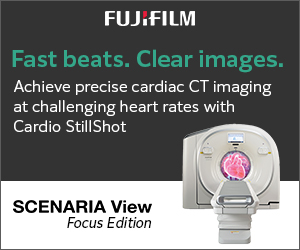|
E-Newsletter • April 2025 |
▼ ADVERTISEMENT

Editor's E-Note
MRI-guided prostate biopsy has changed the way patients are treated, and a new technology may further change treatment. Microultrasound (microUS) technology has the potential to not only allow faster biopsies, but also make them more widely available. In a clinical trial, researchers found little diference in outcomes among men who received MRI-guided biopsy, MRI-guided biopsy followed by microUS-guided biopsy, and microUS-guided biopsy alone. The potential to perform prostate biopsies without MRI guidance or a drop in efficacy has experts intrigued.
For more of the latest imaging news, visit us on X, formerly known as Twitter, and/or Facebook.
Enjoy the newsletter.
— Dave Yeager, editor |
|
|
| In This E-Newsletter
|
▼ ADVERTISEMENT
 |
|
|
Microultrasound Shows Promise for Faster Prostate Biopsies
OPTIMUM is the first randomized trial to compare microultrasound (microUS)-guided biopsy with MRI-guided biopsy for prostate cancer. It involves 677 men who underwent biopsy at 19 hospitals across Canada, the United States, and Europe. Of these, half underwent MRI-guided biopsy, a third received microUS-guided biopsy followed by MRI-guided biopsy, and the remainder received microUS-guided biopsy alone.
▼ ADVERTISEMENT

MicroUS was able to identify prostate cancer as effectively as MRI-guided biopsy, with very similar rates of detection across all three arms of the trial. There was little difference even in the group who received both types of biopsies, with the microUS detecting the majority of significant cancers.
Around a million prostate cancer biopsies are carried out each year in Europe, a similar number in the United States, and around 100,000 in Canada. The majority of biopsies are conducted using MRI images fused onto conventional ultrasound, as this enables urologists to target potential tumors directly, leading to more effective diagnosis. MRI-guided biopsy requires a two-step process (the MRI scan followed by the ultrasound-guided biopsy), requiring multiple hospital visits and specialist radiological expertise to interpret the MRI images and fuse them onto the ultrasound.
▼ ADVERTISEMENT

MicroUS has higher frequency than conventional ultrasound, resulting in three times greater resolution images that can capture similar detail to MRI scans for targeted biopsies. Clinicians such as urologists and oncologists can be easily trained to use the technique and interpret the images, especially if they have experience in conventional ultrasound. MicroUS is cheaper to buy and run compared with MRI and could enable imaging and biopsy to be carried out during one appointment, even outside a hospital setting.
The results of the OPTIMUM trial could have a similar impact to the first introduction of MRI, according to lead researcher on the trial, Laurence Klotz, a professor of surgery at the University of Toronto’s Temerty Faculty of Medicine and the Sunnybrook chair of prostate cancer research.
|
New Ultrasound Technique Images Cellular Structures
Previously unused for body tissue and cell imaging, researchers from Delft University have developed a new ultrasound technique to image capillaries and cells.
Study Reveals Abnormalities in Blast Exposure Patients
A study published in Radiology revealed that military service members who have been in the radius of explosive blasts have changes in “functional connectivity” in various brain regions.
Multimodal AI Useful for Chest X-ray Evaluations
A study published in Nature Communication demonstrates the use of a multimodal AI model that can generate “free-text findings” from X-ray images. |
“Expression of diagnostic certainty is a crucial aspect of the radiology report, as it influences significant management decisions. This study takes a novel approach to analyzing and calibrating how radiologists express diagnostic certainty in chest X-ray reports, offering feedback on term usage and associated outcomes.”
— Atul B. Shinagare, MD, an associate professor of radiology at Harvard Medical School, on research assessing the reliability of radiologists’ diagnostic reports |
|
|
COVER STORY
Making Connections
AI is aiding radiologists in tracking follow-ups and preventing patients from “falling through the cracks.”
FEATURE
Breathing Room
The standard pulmonary function test is often difficult for those with reduced lung capacity. By combining AI and CT, radiologists have developed a newer, more effective method of measuring lung function.
|
|
|
| Advertising Opportunities |
Have a product or service you want to market to radiology professionals? Utilize the reach of Radiology Today Magazine to accomplish your marketing goals. Email our experienced account executives today at sales@gvpub.com or call 800-278-4400 for more information.
|
| © 2025 Radiology Today Magazine |
|
|